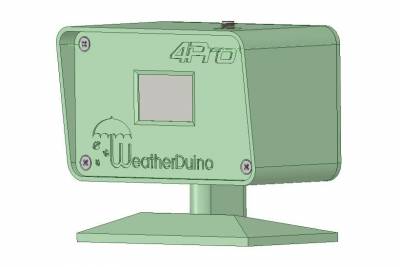
Air Quality Monitor II
Overview
NOTE: There is a new version of this device, the Air Quality Monitor III
The WeatherDuino Air Quality Monitor II measures PM2.5 and PM10 dust particles which are important indicators of air pollution.
Based on the PM2.5 and PM10.0 readings, the Air Quality Index is computed. User can chose USA (EPA), Europe (EAQI), UK (DAQI) or Australian (AQC) standards,
The Air Quality Monitor can also be used to monitor CO2 levels in a room, greenhouse or outside.3)
The AQM II was designed to be installed in places with WiFi Coverage. It can also work without a WiFi connection but several functions will be unavailable.
Key features
- Can be used as a stand-alone device (doesn't require a WeatherDuino Weather Station) for monitoring the Air Quality in any place of your home, indoor or outdoor.
- Can transmit Air Quality and T/H data to WeatherDuino receivers (when equipped with the RF transmitter).
- OLED display (Optional item. It is not necessary to install the OLED display, for example in a unit which is operating outdoors and sending data to a WeatherDuino receiver).
- Can upload Air Quality data to online services like Thinkspeak, or to your own server (eg. to store data in a database).
- Several units can be used to form an Air Quality Network. When a unit receives an HTTP GET it sends back the Air Quality data in JSON format.
- Powered via micro USB connector or connector on the PCB.
- Software can be upgraded by Over the Air (OTA) (requires WiFi connection).
The picture below shows what you get on a WeatherDuino receiver when the Air Quality Monitor II is setup to transmit data over radio frequency.

What is needed and is not included:
- Power supply: 5V - 500mA. Average consumption is below 100mA, but when the sensors are being read, power requirement increases.
- Temperature / Humidity sensor (HTU21D or SHT31)
- MH-Z19B CO2 sensor (can be assembled directly on the PCB with or without a socket, user choice).
- One dust particle sensor. Currently two models of dust particle sensors are supported:
- Nova SDS011 made by Inovafitness.
Several scientific reports are listed at the bottom of this web page giving more information on these sensors and evaluating their performance.
Optional Items
- 1.3“ OLED display (4 pins - I2C interface)
- H34C ASK 433Mhz transmitter plus SMA connector (can be supplied assembled on the PCB, ask for it when ordering)
Outdoor install recommendations
Install the AQM II in a box with vent holes, away from any source of smoke, in a well ventilated place, but not directly exposed to weather elements, like rain, strong winds or direct sunlight.
As an example, a well ventilated porch is a good place.
Preferably install the AQM II in a place with WiFi coverage.
Board Size
85.00mm x 49.60mm

Technical Data
Power Requirements: 5VDC 500mA Microcontroller: 32-bit Tensilica L106 microcontroller
Dust Sensor: PMS7003 or Nova SDS011
CO2 Sensor: MH-Z19 (optional)
RF Frequency: 433Mhz or 315Mhz 4)
Custom Box for the WeatherDuino Air Quality Monitor II
Once again, Jarek (from Poland) has designed a fantastic custom case for the WeatherDuino Air Quality Monitor II.
Anyone with access to a 3D printer can print it, or alternatively order it through any of the several 3D print services available online
There are two versions of this box. One is for the units fitted with the OLED display (called indoor version) and the other is for units without the OLED display (called outdoor version).
The files required for 3D printing are freely available here:
Indoor Version: https://www.thingiverse.com/thing:3608306
Outdoor Version: https://www.thingiverse.com/thing:3608146
If you don't have a 3D printer, you can order your case directly from online 3D printing services like 3Dhubs.
Footnotes
1) - The very expensive PurpleAir Air Quality Monitor uses a Plantower dust sensor (model PMS5003, which is older than the PMS7003 used on WeatherDuino AQM).
2) - See systems compatibility here.
3) - Accurate measurement of CO2 concentration in the open air is a very complicated task, not achievable with simple equipment. According to its published specifications the error margin of a MH-Z19 sensor is 50ppm
4) - Must match the frequency used by other Transmitter units.
A few examples of the use of the PMS7003 dust sensor from the scientific literature
Badura, M., Batog, P., Drzeniecka-Osiadacz, A. and Modzel, P (2018) Evaluation of Low-Cost Sensors for Ambient PM2.5 Monitoring. Journal of Sensors, Article ID 5096540, 16 pages. https://doi.org/10.1155/2018/5096540
Johnston, S.J. and nine others (2019) City Scale Particulate Matter Monitoring Using LoRaWAN Based Air Quality IoT Devices. Sensors 2019, 19, 209; doi:10.3390/s19010209. https://www.mdpi.com/1424-8220/19/1/209


